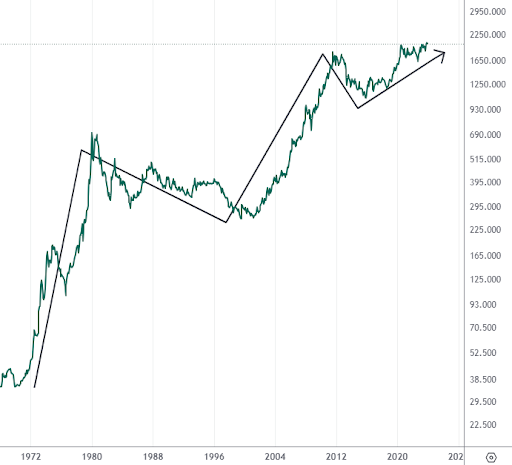What Is A Good Amount To Invest In Gold?
When adding gold to your investment portfolio, consider generally accepted proportions:
-
Traditional investors prioritize stability and diversification with a 5-10% gold allocation
-
Conservative investors seeking security can opt for a smaller 1-5% share.
-
Aggressive investors, comfortable with higher potential returns and increased risk, can target a more significant 10-20% allocation.
For a balanced precious metal portfolio, consider a 75% gold and 25% silver mix, harnessing gold's long-term stability and inflation protection alongside silver's diversification.
Gold has always been seen as a symbol of stability and financial security. Its characteristics include acting as a safeguard against inflation, serving as a haven in times of economic uncertainties, and retaining its value over the long run.
However, a crucial question arises for investors seeking to capitalize on its advantages: What is the optimal amount of gold to include in my investment portfolio?
Do you want to buy gold? Open an account on Roboforex!-
How much of my net worth should be in gold?
Determining the ideal gold allocation in your portfolio is a nuanced decision shaped by factors like investment goals, risk tolerance, and financial situation. While a traditional approach suggests 5-10% allocation, conservative strategies may opt for 5% or less, and aggressive methods could reach 10-15% or even higher. Diversifying across asset classes is crucial for effective risk management.
How Much Gold & Silver Should You Consider Owning?
Traditionally, experts suggest a 10% gold allocation as a hedge against market volatility and inflation, offering stability during economic downturns.
But there is no universal answer to this question. However, a balanced precious metal portfolio suggests 75% gold and 25% silver. Silver mirrors gold's benefits but with higher volatility, suitable for short-term trading and potentially riskier for long-term investors.

Long-Term Gold Price Perspective
The long-term prospects for gold appear promising, but predicting specific future prices involves uncertainties. However, expert forecasts and market analyses can glean insights into potential trends. To thoroughly explore gold's future, get into the article - Gold (XAU) Price Prediction 2024, 2025, 2030.
This article offers in-depth market analysis and expert forecasts, providing valuable information to guide your investment journey.
Determining the ideal amount of gold in your portfolio hinges on various factors, including:
-
Goals
-
Risk Tolerance
-
Overall Financial Situation
Your Investment Goals
Tailoring your allocation requires a deeper understanding of the financial situation. Here are the three key investment goals and their respective considerations for gold ownership.
-
Retirement Planning
-
Short-Term Investment
-
Hedge Against Inflation
A standard recommendation suggests dedicating 5-10% of your retirement portfolio to this precious metal. This strategically shields your assets from the erosive effects of inflation and provides stability during turbulent market conditions. However, it's crucial to remember that gold is not a growth-oriented asset and should only be partially relied upon for generating significant returns.
Gold might not be ideal if you're primarily focused on short-term gains. Its price can be volatile, leading to significant fluctuations in value over shorter timeframes. This inherent volatility introduces substantial risk, particularly for investors seeking immediate returns. While the potential for short-term gains exists, the associated risk often outweighs the potential rewards for this specific investment goal.
Gold has historically been recognized as a reliable hedge against inflation, acting as a haven when the purchasing power of currencies weakens. Its long-term price trajectory typically rises alongside inflation, helping preserve your assets' value. However, it's important to note that gold isn't a perfect solution. Its performance can be inconsistent, and other asset classes, such as TIPS (Treasury Inflation-Protected Securities), may offer more direct protection against inflation. A diversified portfolio incorporating various inflation-resistant assets is often the most effective strategy.
Your Risk Tolerance
Risk tolerance is critical in determining your gold allocation, reflecting your comfort with potential losses and investment volatility. Here's how it can impact your gold ownership:
-
Conservative Investor
-
Aggressive Investor
Prioritizing stability and risk minimization, a conservative investor may find a smaller gold allocation of 5% or less suitable. The focus is on asset classes with lower volatility and more predictable returns.
Comfortable with higher potential rewards and increased risk, an aggressive investor may allocate 10-15% or more to gold. The aim is to leverage its potential for capital appreciation and diversification.
Remember, risk tolerance isn't static. It evolves and can be influenced by life changes. Regularly reassess and adjust your gold allocation to maintain a balanced portfolio aligned with your changing risk tolerance.
Your Overall Financial Situation
While investment goals and risk tolerance form the core pillars of your gold allocation strategy, your overall financial situation also plays a significant role:
-
Age
-
Other Investments
Your age can significantly influence your approach to gold ownership. Younger investors with a longer time horizon can take more risk and benefit from a higher gold allocation. This allows them to take advantage of potential long-term price appreciation and ride out market fluctuations without jeopardizing their financial goals. Conversely, individuals nearing retirement or approaching significant life changes might prioritize stability and opt for a smaller gold allocation, focusing on preserving their accumulated wealth.
The existing composition of your investment portfolio is another crucial factor to consider. Your need for a significant gold allocation diminishes if your portfolio already boasts a diversified mix of asset classes, including equities, bonds, and real estate. In this scenario, a smaller percentage would suffice to maintain portfolio diversification and hedge against potential market downturns. However, if your portfolio lacks diversification or is heavily concentrated in a single asset class, a more significant gold allocation could provide valuable diversification benefits and mitigate risk.
By incorporating your age and existing investments into your gold allocation strategy, you can craft a more personalized approach that aligns with your circumstances and financial goals. Balancing potential rewards and risk management is critical, ensuring your gold allocation complements your overall financial roadmap.
Best brokers to trade gold (XAUUSD)

Advantages and disadvantages of owning gold
👍 Advantages
• Hedge against inflation: Gold historically performs well during periods of inflation, as its price tends to increase alongside rising costs.
• Safe haven asset: Gold is considered a "safe haven" asset, meaning its price tends to rise during economic uncertainty or market volatility.
• Portfolio diversification: Gold can help diversify your portfolio and reduce your overall risk, as its performance is not correlated with other asset classes like stocks or bonds.
• Tangible asset: Gold is a tangible asset you can physically hold, unlike stocks or bonds, which are electronic entries.
• Long-term store of value: Gold has been a valued asset for centuries and will likely remain, making it an excellent long-term store of value.
👎 Disadvantages
• Low potential for income: Gold does not pay dividends or interest, unlike stocks or bonds.
• Volatile asset: Gold prices can be volatile in the short term, meaning you could lose money if you sell your gold during a downturn.
• Storage and security costs: If you purchase physical gold, you will need to incur storage and security costs.
• Opportunity cost: Investing in gold could mean missing out on potential returns from other asset classes.
• Limited liquidity: It may be challenging to sell your gold quickly if you need to access the cash
Summary
Consider allocating 1 to 20 percent of your investment capital to owning gold, with a balanced approach suggesting 75% gold and 25% silver for diversification. This decision influences goals, risk tolerance, and overall financial situation. Gold's volatility challenges short-term investors but remains a historical hedge against inflation.
Team that worked on the article
Upendra Goswami is a full-time digital content creator, marketer, and active investor. As a creator, he loves writing about online trading, blockchain, cryptocurrency, and stock trading.
Professionally, he has been a marketing professional running his agency for three years now. His agency helps finance projects to grow with the help of internet technologies. Upendra Goswami is an active investor and enthusiast of stocks and cryptocurrency.
Knows about
trading, blockchain, cryptocurrency, stock trading
Alumnus of
JECRC UDML College of Engineering, Jaipur
Dr. BJ Johnson is a PhD in English Language and an editor with over 15 years of experience. He earned his degree in English Language in the U.S and the UK. In 2020, Dr. Johnson joined the Traders Union team. Since then, he has created over 100 exclusive articles and edited over 300 articles of other authors.
The topics he covers include trading signals, cryptocurrencies, Forex brokers, stock brokers, expert advisors, binary options. He has also worked on the ratings of brokers and many other materials.
Dr. BJ Johnson’s motto: It always seems impossible until it’s done. You can do it.
Mirjan Hipolito is a journalist and news editor at Traders Union. She is an expert crypto writer with five years of experience in the financial markets. Her specialties are daily market news, price predictions, and Initial Coin Offerings (ICO). Mirjan is a cryptocurrency and stock trader. This deep understanding of the finance sector allows her to create informative and engaging content that helps readers easily navigate the complexities of the crypto world.










